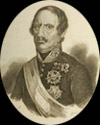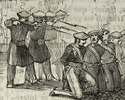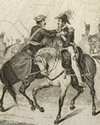19th Century´s militar history in the Basque Country
RAFAEL MAROTO. (1783-1853)
 Born in Lorca (Murcia) in 1783, Maroto began his military career like many others, in the French invasion of 1808, after which he went to Peru to fight the South-American independentists. In 1813, he was sent to Chile, which had been emancipated since 1810 and took Santiago in 1814, which increased his rank to brigadier. He continued in South America leading the struggle against its emancipation, but was defeated at the Battle of Chacabuco, which led to the independence of Chile in 1817 and Ayacucho in 1824, marking the end of Spanish domination on the South-American continent.
Born in Lorca (Murcia) in 1783, Maroto began his military career like many others, in the French invasion of 1808, after which he went to Peru to fight the South-American independentists. In 1813, he was sent to Chile, which had been emancipated since 1810 and took Santiago in 1814, which increased his rank to brigadier. He continued in South America leading the struggle against its emancipation, but was defeated at the Battle of Chacabuco, which led to the independence of Chile in 1817 and Ayacucho in 1824, marking the end of Spanish domination on the South-American continent.
Maroto returned to Spain and was put in charge of organising the realist militia in Asturias and Toledo. His conservative ideology led him to sympathise with the Infante Don Carlos, whom he accompanied in his exile to Portugal and subsequently London. Nonetheless, he did not join the Carlist army until 1835. In August 1836, he was named commanding general of Catalonia but resigned two months later after a poor campaign. He was arrested in France trying to join the northern front and imprisoned in Tours. He escaped to Bordeaux where he contacted the Minister Erro offering to join the royal barracks, but the Minister answered that he should remain abroad until the case opened regarding his conduct in Catalonia had been closed.
In May 1838, Don Carlos called Maroto to take command of the Carlist army in a time of crisis and division among his generals.
 In three months, he reorganised the Carlist troops and prepared them to face the Liberal army once again. However, it was too late to direct the war. The troops were exhausted, as were the inhabitants of the primary scene of the conflict - the Basques. In early 1839, Maroto established contact with the Liberal generals to try and reach an agreement to end the war. The division of the Carlist army between those in favour of the pact and those who wanted to carry on with the war at any cost became clear when Maroto ordered the execution of four generals in February in Estella.
In three months, he reorganised the Carlist troops and prepared them to face the Liberal army once again. However, it was too late to direct the war. The troops were exhausted, as were the inhabitants of the primary scene of the conflict - the Basques. In early 1839, Maroto established contact with the Liberal generals to try and reach an agreement to end the war. The division of the Carlist army between those in favour of the pact and those who wanted to carry on with the war at any cost became clear when Maroto ordered the execution of four generals in February in Estella.
Don Carlos published an edict to remove Maroto and declare him a traitor, but Maroto controlled the situation and had the support of most of the Carlist troops. The pretender was forced to retract and recognise him as commander of his army again. Maroto expelled his enemies from the royal barracks and began conversations with Lord John Hay, head of the British Navy in the Cantabrian for him to act as mediator in negotiations with the Liberal generals.
 This process ended with the Bergara Convention, which put an end to the war on the northern front after the agreement with Espartero for the Carlists to put down their arms in exchange for respect for the Fueros (regional charters). On the 31st of August, five battalions from Castile, three from Guipuzcoa and eight from Bizcaya surrendered in Bergara, and Don Carlos was forced into exile with his unconditional supporters. The war dragged on for another year in Catalonia and the Maestrazgo because Cabrera efused to accept the Convention, though there was no possibility of a Carlist victory.
This process ended with the Bergara Convention, which put an end to the war on the northern front after the agreement with Espartero for the Carlists to put down their arms in exchange for respect for the Fueros (regional charters). On the 31st of August, five battalions from Castile, three from Guipuzcoa and eight from Bizcaya surrendered in Bergara, and Don Carlos was forced into exile with his unconditional supporters. The war dragged on for another year in Catalonia and the Maestrazgo because Cabrera efused to accept the Convention, though there was no possibility of a Carlist victory.
Rafael Maroto became the epitome of a traitor to the Carlist cause, despite having put an end to a war that had lasted seven years and following the wishes of the majority of his troops and the Basque population. In 1847, he returned to Chile until his death in 1853.

